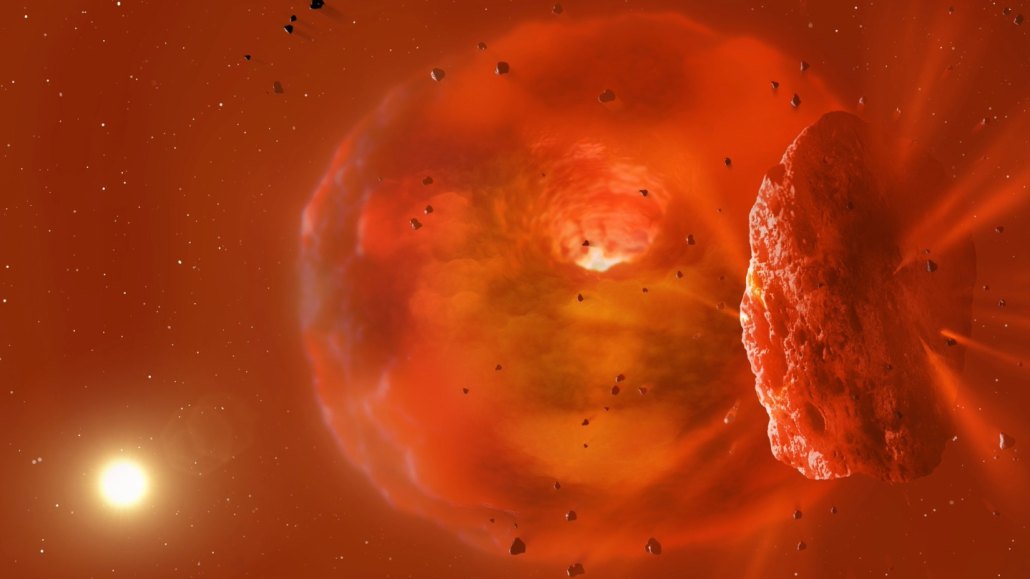In a first, astronomers spot the afterglow of an exoplanet collision
Two Neptune-sized planets around a remote star may have hit each other and cast an infrared glow

The collision of two exoplanets may have left behind a donut-shaped cloud of vaporized rock and water (illustrated), which cast an infrared glow visible to telescopes.
Mark Garlick
By Elise Cutts
- More than 2 years ago
Read another version of this article at Science News Explores
In a solar system about 1,800 light-years from Earth, two planets smacked into one another in an impact that vaporized them both. And astronomers caught them in the act.
An incandescent blob of leftover planet, lingering after an impact, could explain a surge of infrared light from a remote star, researchers report October 11 in Nature. And the ensuing debris field could also explain a subsequent dimming of the star, the team says. While scientists have glimpsed planetary debris in other solar systems before, no one has seen the smoldering remains of a collision between exoplanets until now (SN: 5/8/23).
“The possible detection of a post-impact body is really exciting,” says astrophysicist Philip Carter of the University of Bristol in England, who was not involved in the new study. “As far as I’m aware, no one’s claimed this before.”
As is often the case for exciting astronomical discoveries, detecting the aftermath of this cosmic smackdown involved more than a little luck.
Astronomer Matthew Kenworthy wasn’t hunting for giant impacts. “I was looking for rings” around exoplanets, he says (SN: 2/1/15). So he was scouring telescope survey data for stars that flicker or dim in unusual ways. And when the ASAS-SN survey — an ongoing project to monitor the entire sky for exploding stars — captured the sunlike star ASASSN-21qj repeatedly dimming in visible light, “I immediately jumped on it,” says Kenworthy, of Leiden Observatory in the Netherlands.
As he was analyzing the fading star, Kenworthy stumbled upon another clue — on social media. One of his posts on Twitter (now called X) about ASASSN-21qj’s unusual behavior caught the eye of citizen scientist Arttu Sainio. “I tweeted out saying: ‘Oh, this is amazing, this star is fading!’” Kenworthy says. “Then he said: ‘Oh, by the way, did you realize the star had brightened up [in infrared]?’”
Sainio pointed out that infrared data from NASA’s orbiting WISE telescope showed a strong uptick in infrared radiation from the star about 900 days before the dimming started. Kenworthy’s hopes for rings were dashed. But maybe he and his colleagues had found something else just as fascinating.
“It just totally changed the story,” Kenworthy says.
The researchers realized that a giant impact could neatly tie together the spontaneous infrared glow and the visible light dimming that followed more than two years later. Their calculations suggest that two Neptune-sized planets collided, vaporizing each other and forming a hot, donut-shaped body of vaporized rock — the source of the infrared glow. ASASSN-21qj later dimmed when impact debris smeared out around the star and blocked some of its light.
Alternatively, it’s possible that astronomers observed two separate events: an infrared glow from dust warmed by starlight, perhaps left behind by a collision between close-orbiting protoplanets, followed by dimming as a big disk of unrelated material passed in front of the star. But two rare events happening in close succession is “really, really, really unlikely,” Kenworthy says.
The putative post-impact blob could one day coalesce into a planet. And as the remaining debris shears out into a disk orbiting the star, it too might eventually collect onto the new planet or form moons around it.
How long all that might take isn’t clear, Carter says. It could happen within a few years or perhaps several thousand. “The models of these impact remnants are still in the very early stages,” he says. Either way, continuing to observe the post-impact material over the coming years will give scientists a rare chance to witness, not just simulate, what happens after a planetary collision.
“You expect astronomical processes to take astronomical amounts of time. And it’s like: Nope! This was very fast. This happened over just a few years,” Kenworthy says. “It’ll just be fascinating to see how it evolves over time, in the next 10 or 20 years.”







